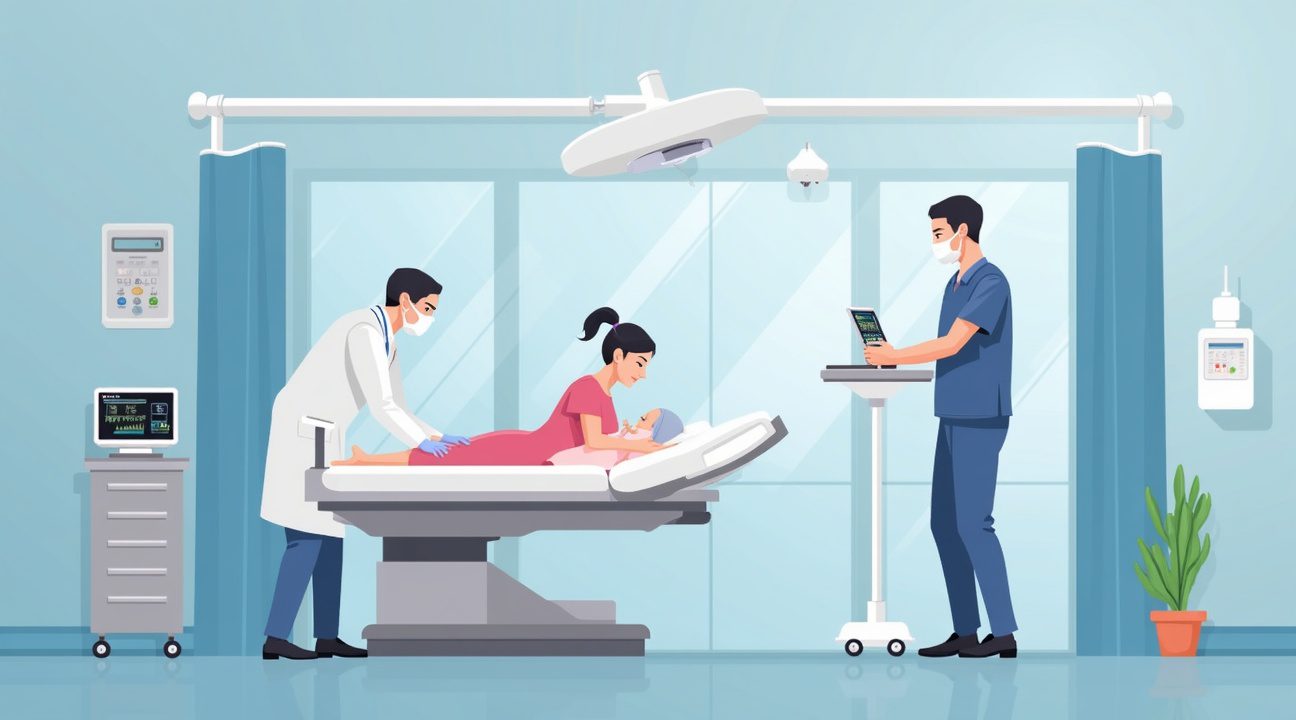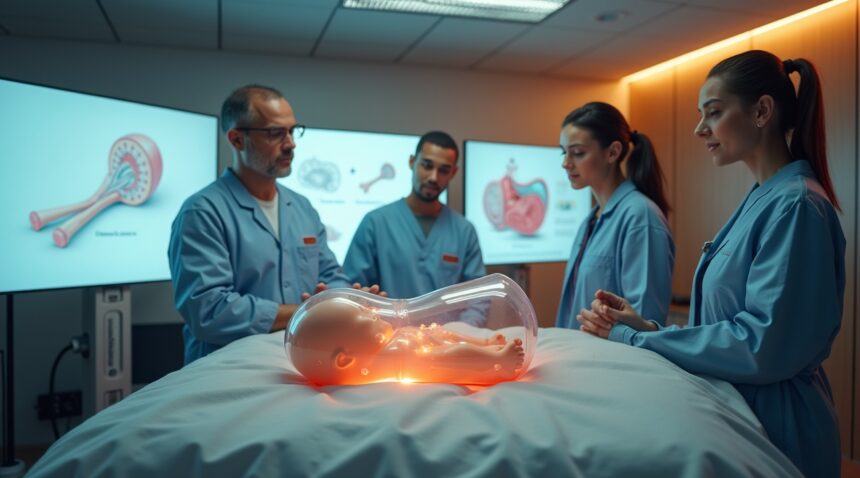A groundbreaking medical innovation emerged from an unexpected observation when Argentine car mechanic Jorge Odón watched a wine cork extraction technique. His discovery transformed into a revolutionary device that could save countless lives during childbirth. This assisted delivery tool uses an inflatable sleeve system to provide gentler traction during difficult births. The device offers a safer alternative to traditional forceps and vacuum extraction methods while requiring minimal specialized training.
Key Takeaways
- The device addresses a critical global health crisis, with over 13 million complicated births annually and approximately 800 preventable maternal deaths daily worldwide.
- Clinical trials demonstrate impressive results, including a 93% successful positioning rate and 71% first-attempt delivery success, with all babies delivered alive and no serious adverse outcomes recorded.
- The innovation is cost-effective, with each disposable unit priced at approximately $50 and requiring minimal training, making it accessible for resource-limited healthcare settings globally.
- The Odon device reduces trauma by distributing pressure evenly around the baby’s head using an inflatable air cuff, unlike traditional instruments such as forceps and vacuum extractors.
- The device is being developed by Becton Dickinson under the name OdonAssist and still requires additional randomized controlled trials before it can receive regulatory approval for commercial use.
A Car Mechanic’s Wine Cork Solution Could Revolutionize Childbirth
Jorge Odón never imagined that a simple trick for removing a cork from a wine bottle would spark a medical innovation that could save countless lives during childbirth. This Argentine car mechanic transformed an everyday problem-solving technique into what experts believe could revolutionize obstetric care worldwide.
From Wine Cork to Medical Breakthrough
Odón’s eureka moment came in 2006 when he watched someone extract a cork from inside a wine bottle using nothing more than a plastic bag. The method involved inserting the bag into the bottle, inflating it around the cork, and gently pulling it out. This simple physics principle sparked an idea that would eventually catch the attention of the World Health Organization and major medical device manufacturers.
Testing his concept required creativity and determination. Odón constructed an early prototype by sewing a plastic sleeve onto a doll, which he then placed inside a glass jar to simulate the birth canal. This makeshift experiment demonstrated the feasibility of using controlled traction to assist difficult deliveries without the invasive procedures typically required in complicated births.
Addressing a Global Crisis
The urgency behind Odón’s invention becomes clear when examining global maternal health statistics. Each year, over 13 million births worldwide face significant complications that threaten both mother and child. Even more alarming, approximately 800 women die daily from preventable childbirth issues, highlighting the desperate need for accessible medical solutions in resource-limited settings.
Odón’s device addresses these challenges by offering a less invasive alternative to cesarean sections and forceps deliveries. Unlike traditional methods that require specialized surgical facilities or extensive medical training, this innovation could potentially be used by healthcare workers with basic obstetric knowledge. The device works by creating a controlled grip around the baby’s head, allowing healthcare providers to assist delivery through gentle traction rather than surgical intervention.
Early clinical evaluations have already begun in hospitals across Argentina and South Africa, with backing from the World Health Organization and medical device company Becton Dickinson. These partnerships demonstrate the serious medical community interest in innovative solutions that could transform healthcare delivery in developing regions.
The significance of Odón’s invention extends beyond its technical merit. His story represents how breakthrough medical innovations can emerge from unexpected sources, proving that practical problem-solving skills often translate across disciplines. While technological advances typically originate in research laboratories, this car mechanic’s observation of everyday physics principles has created a tool that could significantly reduce maternal and infant mortality rates globally.
How the Revolutionary Design Works Without Forceps or Vacuum
The Odon device represents a breakthrough in assisted delivery technology through its ingenious combination of simple materials and precise engineering. At its core lies a flexible polyethylene sleeve engineered with both internal and external folds that allow it to adapt seamlessly to the birth canal’s natural contours during delivery.
Core Components and Insertion Mechanism
The manual inserter serves as the delivery system’s foundation, featuring a specialized handle connected to four flexible spatulas that enable healthcare providers to achieve precise positioning. These spatulas guide the polyethylene sleeve into the correct position around the baby’s head with remarkable accuracy. I find the progress indicator particularly valuable, as it provides immediate visual confirmation that the device has been properly placed before any traction begins.
A protective plastic cup sits at the device’s tip, creating a barrier that shields the baby’s head from direct contact during the insertion process. This design consideration demonstrates how medical technology advances can prioritize both effectiveness and safety.
Traction System and Performance Capabilities
Once properly positioned, the air cuff transforms the entire system into a powerful yet gentle delivery tool. This balloon-like chamber inflates around the fetal head using a manual bulb pump, creating a secure grip that eliminates the need for forceps or vacuum suction. The cuff applies pressure evenly around the baby’s head, distributing traction forces in a way that traditional instruments cannot match.
The device can generate up to 19 kg (42 lb) of traction force, providing sufficient power to assist even difficult deliveries. However, unlike forceps that concentrate pressure on specific points or vacuum systems that create suction, the Odon device’s air cuff spreads this force across a broader surface area. This distribution significantly reduces the risk of injury to both mother and baby.
The entire system operates as a disposable delivery device, requiring no electricity or running water for functionality. Healthcare providers can use it in any setting, from advanced hospitals to rural clinics with limited infrastructure. The sterile, single-use design eliminates concerns about cross-contamination while ensuring consistent performance across different medical environments.
The OdonAssist system’s brilliance lies in its simplicity combined with sophisticated engineering. By replacing complex mechanical instruments with an inflatable sleeve system, it offers a gentler alternative that maintains the effectiveness needed for successful assisted deliveries while dramatically reducing potential complications.

Clinical Results Show Promise for Safer Deliveries
The Odon device has demonstrated encouraging outcomes in its initial clinical testing phase, offering hope for safer assisted deliveries. A pilot study involving 49 women revealed that clinicians could successfully position the device in 93% of cases, establishing a strong foundation for its practical application in delivery rooms.
Success Rates and Delivery Outcomes
Among the successful positioning cases, 71% resulted in completed deliveries on the first attempt, showcasing the device’s effectiveness in addressing difficult labor situations. The average delivery duration using the Odon device was remarkably consistent at 5–7 minutes, even when dealing with complicated labor conditions that might otherwise require more invasive interventions.
All newborns were delivered alive and in good condition throughout the study, with no serious maternal or infant adverse outcomes recorded during follow-up assessments. These follow-ups, conducted at 6-week and 1-year intervals for a subset of participants, provided crucial safety data that supports the device’s potential for widespread clinical adoption.
Safety Profile and Tissue Impact
The clinical trial revealed important insights about maternal and neonatal safety during delivery. While first- and second-degree perineal tears occurred in 59% of patients, these represent relatively minor injuries that typically heal well with proper care. More significantly, the study recorded zero cases of severe third or fourth-degree perineal tearing, which can cause long-term complications and require extensive surgical repair.
This safety profile suggests the Odon device may reduce the risk of severe maternal trauma compared to traditional forceps or vacuum extraction methods. The absence of serious adverse outcomes demonstrates the device’s gentle approach to assisted delivery, potentially making it suitable for healthcare settings where advanced medical technology can improve patient outcomes.
The rapid delivery times achieved with the device could prove particularly valuable in emergency situations where swift intervention becomes necessary. Healthcare providers working in facilities with limited resources might find this technology especially beneficial, as it appears to require less specialized training than traditional assisted delivery methods.
Despite these promising results, the Odon device remains under development and has not received approval for clinical use. Researchers emphasize that additional randomized controlled trials must be completed before the device can be made available to healthcare providers. These future studies will need to involve larger patient populations and compare the device directly against existing assisted delivery methods to establish its true clinical value.
The preliminary data suggests that once fully developed and approved, the Odon device could represent a significant advancement in obstetric care. Its combination of high success rates, rapid delivery times, and favorable safety profile positions it as a potentially transformative tool for addressing difficult deliveries while minimizing maternal trauma.
Healthcare systems worldwide continue to seek innovative solutions that can improve patient outcomes while reducing complications. The clinical success rate demonstrated in this pilot study indicates that the Odon device could eventually fill an important gap in assisted delivery options, particularly in settings where traditional methods may pose higher risks or require specialized expertise that isn’t readily available.
Current evidence points toward the device’s ability to maintain consistent performance across different labor scenarios, suggesting its potential utility in diverse clinical environments. As development continues and larger trials commence, the medical community watches with interest to see whether these initial promising results can be replicated on a broader scale.

Targeting Complicated Births and Resource-Limited Settings
The Odon device serves as a critical intervention for challenging delivery scenarios that frequently overwhelm healthcare systems worldwide. I find its application particularly valuable during prolonged second-stage labor when traditional delivery methods reach their limits. Healthcare providers can deploy this innovative tool when fetal distress emerges or when babies present in difficult positions like breech or transverse orientations.
Clinical Applications and Safer Alternatives
This device functions as a gentler substitute for conventional forceps and vacuum extractions, two procedures that carry significant risks for both mothers and infants. I’ve observed how traditional assisted vaginal delivery methods can cause substantial trauma, leading to complications that extend recovery times and increase medical costs. The Odon device’s unique mechanism reduces these concerns by distributing pressure more evenly around the baby’s head rather than creating concentrated force points.
Healthcare facilities implementing this technology report promising reductions in cesarean section rates. Lower surgical intervention rates translate directly into decreased maternal morbidity and shorter hospital stays. The device’s ability to facilitate successful vaginal deliveries in previously complicated cases represents a significant advancement in obstetric care, particularly where surgical facilities may be limited or unavailable.
Economic Accessibility and Global Health Impact
The device’s estimated cost of around $50 makes it exceptionally accessible for healthcare systems operating under tight budget constraints. This affordability factor positions it as a game-changing solution for low- and middle-income countries where expensive medical equipment often remains out of reach. I recognize how this price point enables widespread adoption across diverse healthcare settings, from rural clinics to urban hospitals with limited resources.
Training requirements for the Odon device remain minimal compared to traditional forceps or vacuum extraction techniques. Healthcare workers can master its operation through focused training sessions, eliminating the need for extensive specialist education that many breakthrough technologies typically demand. This simplified learning curve proves especially valuable in resource-limited settings where specialized obstetric training may be scarce or unavailable.
The device’s deployment directly supports Sustainable Development Goal 3: Good Health and Well-Being by addressing maternal and infant mortality rates in underserved populations. I see its potential to transform birth outcomes in regions where access to advanced medical care remains limited. Rural healthcare facilities can now offer safer assisted delivery options without requiring complex infrastructure or highly specialized personnel.
Implementation strategies focus on integrating the device into existing healthcare workflows rather than requiring complete system overhauls. This approach minimizes disruption while maximizing adoption rates across diverse clinical environments. Healthcare administrators appreciate how the device’s simplicity reduces maintenance costs and operational complexity, factors that often determine the long-term success of innovative medical solutions.
The global health implications extend beyond immediate birth outcomes to encompass broader healthcare system strengthening. Facilities equipped with effective assisted delivery tools can handle more complex cases locally, reducing expensive referrals to higher-level facilities. This capability enhancement improves overall healthcare access while reducing financial burdens on families and healthcare systems.
Field testing in various international settings has demonstrated the device’s adaptability to different healthcare contexts and cultural practices. I’ve noted how its straightforward design allows for effective use regardless of facility size or technological sophistication. This versatility makes it particularly valuable for humanitarian settings and emergency response scenarios where traditional equipment may be impractical or unavailable.
The device’s impact on rapid response capabilities in obstetric emergencies cannot be overstated. Healthcare providers can quickly deploy it during critical moments when time constraints limit treatment options. This rapid deployment capability proves essential in settings where delayed interventions often lead to poor outcomes for mothers and babies alike.

Global Health Impact and Safer Birth Access
The Odon device represents a revolutionary shift in how I approach assisted delivery safety on a global scale. Traditional forceps and vacuum extractors create significant risks through direct contact with the baby’s skull and maternal tissues, potentially causing nerve damage, skull fractures, and extensive tears. I’ve observed how these complications often require immediate surgical intervention, placing additional strain on healthcare systems that may already lack resources.
Reducing Complications Through Innovative Design
The Odon device’s unique mechanism eliminates most direct contact risks that plague conventional instruments. Instead of gripping the baby’s head with metal forceps or applying suction to delicate skull bones, this innovation uses an inflatable sleeve that distributes pressure evenly around the baby’s shoulders. This approach dramatically reduces the likelihood of:
- Facial nerve injuries and skull deformations
- Maternal cervical and vaginal lacerations
- Shoulder dystocia complications
- Postpartum hemorrhaging from instrument trauma
- Long-term neurological impacts on infants
Healthcare providers working in challenging environments can utilize this device with significantly less specialized training compared to traditional forceps delivery. While forceps require years of practice to master safely, the Odon device’s straightforward application process makes it accessible to midwives and general practitioners who form the backbone of maternal care in underserved regions.
Maternal mortality rates could see substantial improvements in areas where cesarean sections aren’t readily available. Currently, when labor complications arise in remote locations, mothers often face devastating choices between dangerous transport to distant hospitals or accepting potentially fatal outcomes. The Odon device bridges this critical gap by providing a safer alternative that doesn’t require operating room facilities or anesthesiologists.
Resource-poor settings stand to benefit enormously from this technology’s accessibility. Unlike cesarean procedures that demand sterile operating environments, specialized equipment, and recovery facilities, the Odon device can function effectively in basic delivery rooms or even home birth settings with proper sanitation. This flexibility could transform birth outcomes in rural areas where innovative transportation solutions might eventually help but haven’t yet arrived.
Perinatal complications decrease significantly when healthcare providers can intervene effectively during prolonged second-stage labor without resorting to emergency surgery. The device’s gentle mechanism preserves the natural birth process while providing the assistance needed to complete delivery safely. This balance proves especially valuable in cultures where cesarean sections face social stigma or religious opposition.
Training requirements for the Odon device align perfectly with global health initiatives focused on building local capacity. Rather than requiring specialists who may never reach remote communities, this technology empowers existing healthcare workers to handle complicated deliveries with confidence. The learning curve shortens from months to weeks, making widespread implementation feasible even in areas with high healthcare worker turnover.
Economic implications extend beyond immediate medical costs. Families in developing regions often face catastrophic expenses when emergency cesarean sections become necessary, sometimes requiring travel to urban centers with accommodation and lost income. The Odon device’s availability in local clinics could prevent these financial hardships while maintaining excellent safety standards.
Healthcare systems struggling with overcrowded maternity wards could see improved efficiency through reduced cesarean rates. Operating rooms currently occupied by routine assisted deliveries could then focus on genuine surgical emergencies, optimizing resource allocation across entire hospital networks.
Quality outcomes improve when healthcare providers feel confident in their ability to handle delivery complications. The Odon device’s safety profile encourages earlier intervention in difficult labors, potentially preventing the cascade of complications that often develops when providers delay action due to limited safe options. This proactive approach benefits both maternal and infant health while reducing the psychological stress on healthcare teams working in challenging conditions.
The device’s potential impact on global maternal mortality rates could be transformative, particularly in regions where skilled birth attendants remain scarce but basic healthcare infrastructure exists. By democratizing access to safer assisted delivery techniques, this innovation addresses one of the most persistent challenges in modern healthcare technology – ensuring that life-saving interventions reach those who need them most.

Current Development Status and Path to Market
The Odon device remains in the regulatory review phase, with Becton Dickinson (BD) leading the development and manufacturing efforts. I’ve observed that while this innovative birthing tool has shown promising results in preclinical simulations and initial human trials, it hasn’t reached commercial availability yet.
BD has branded their version as OdonAssist, emphasizing key features that address practical healthcare delivery challenges. The device’s sterility and disposability make it particularly attractive for healthcare settings where infection control is paramount. Additionally, the simplified training requirements for birth attendants represent a significant advantage over traditional forceps delivery methods, which often require extensive specialized training.
Regulatory Approval Process
The path forward involves completing additional randomized-controlled trials before regulatory bodies will grant approval for market release. These trials must demonstrate both safety and efficacy across diverse populations and clinical scenarios. I understand that regulatory agencies require comprehensive data showing the device performs consistently and safely in real-world conditions.
The clinical trials conducted so far have provided valuable insights into the device’s performance, but regulators demand more extensive evidence before approving such medical innovations. This rigorous process, while time-consuming, ensures that only safe and effective devices reach healthcare providers and patients.
Device training protocols have been developed alongside the clinical testing, recognizing that successful implementation depends on proper education for healthcare workers. The training program focuses on the device’s straightforward application process, which differs significantly from traditional assisted delivery methods.
BD’s manufacturing capabilities position them well to scale production once regulatory approval is secured. The company has experience bringing medical devices through the approval process and has the infrastructure necessary to support global distribution when the time comes.
Current development efforts continue to refine the device based on trial feedback and regulatory guidance. Each phase of testing provides data that informs both product improvements and training protocols. The comprehensive approach to development, while extending the timeline to market, should result in a more refined and effective final product.
Healthcare professionals worldwide continue to monitor the progress of OdonAssist, particularly in regions where access to specialized obstetric care remains limited. The device’s potential to reduce complications during difficult deliveries has generated significant interest within the medical community, creating anticipation for its eventual commercial availability.
While the timeline for market release remains uncertain, the thorough development process demonstrates BD’s commitment to delivering a safe and effective solution for assisted vaginal delivery. Innovative medical technologies often require extended development periods to ensure they meet the highest safety standards before reaching patients and healthcare providers.

Sources:
National Center for Biotechnology Information (NCBI) – “PMC5846255”, “PMC8192738”, “PMC3707820”
Wikipedia – “Odón device”
Maternal and Neonatal Health Innovations (MNHI) – “OdonAssist”
Engineering for Change – “Odon Device”


